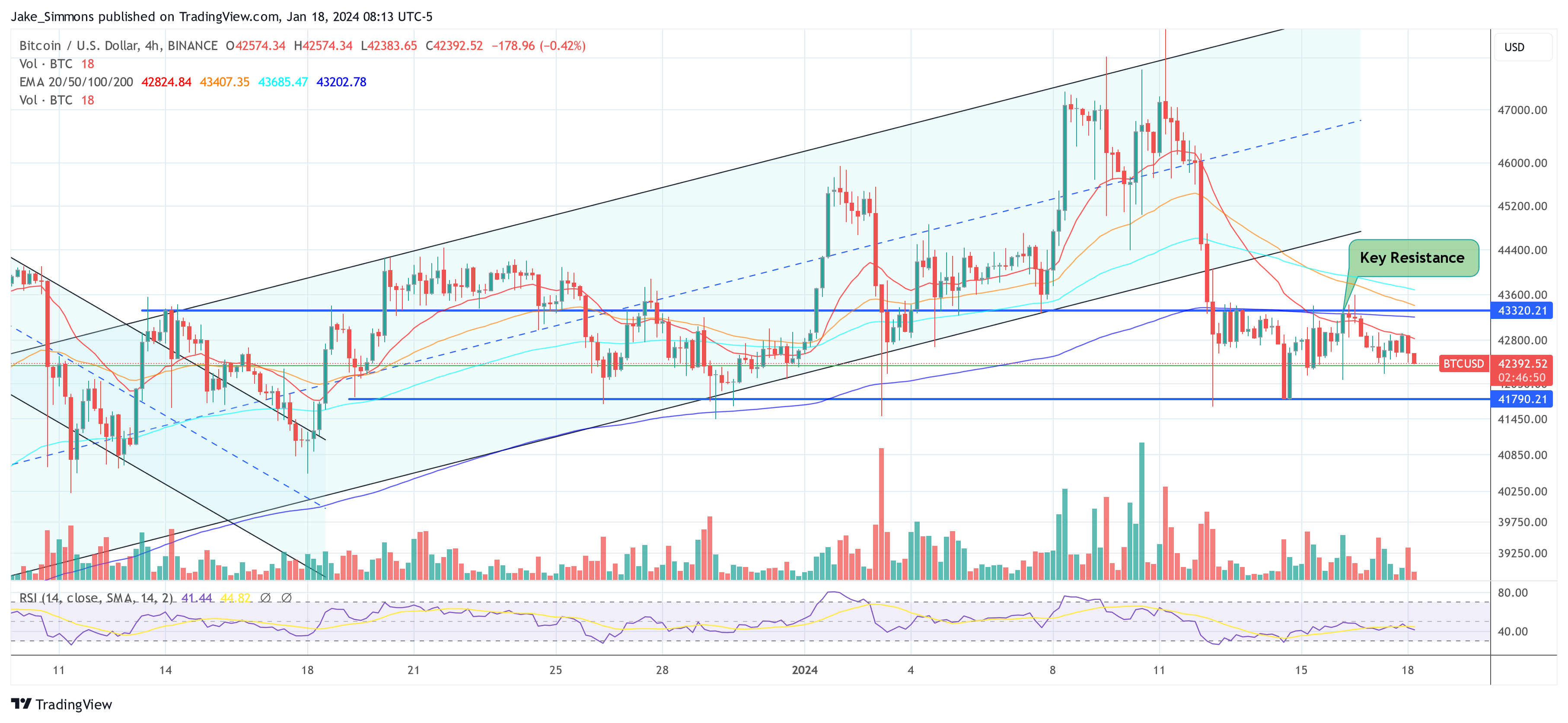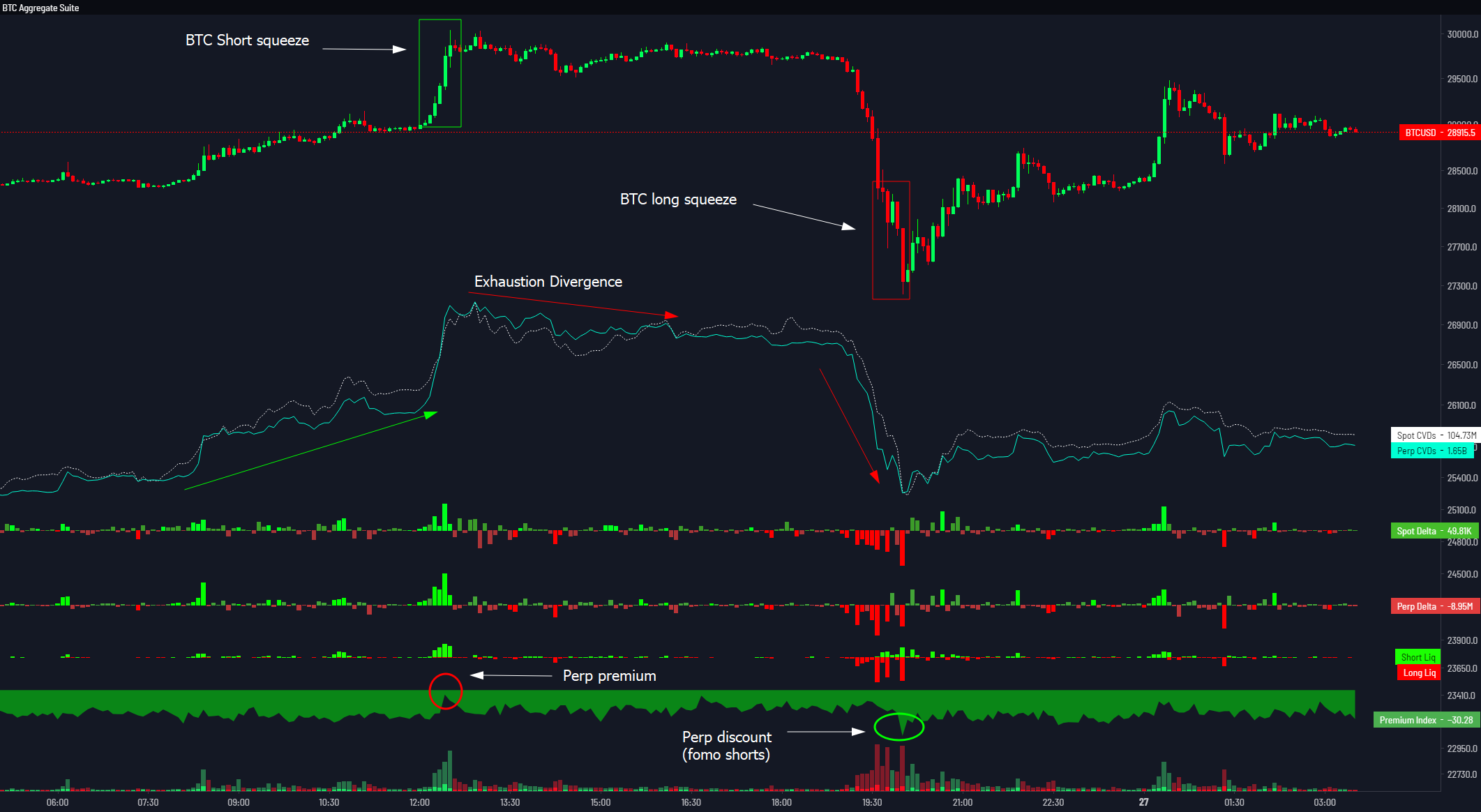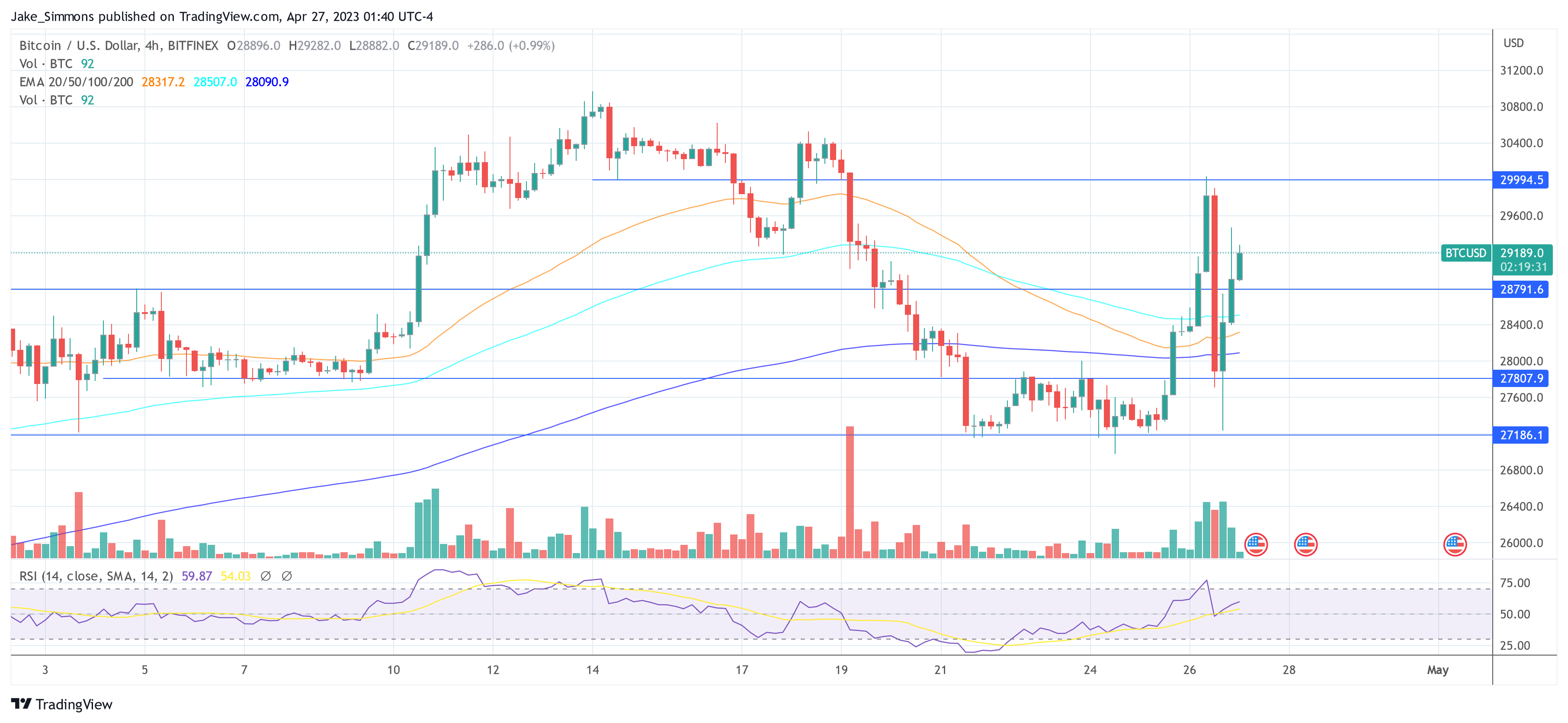
Crypto exchange Coinbase has suffered a ‘system wide’ outage, rendering platform unusable.
Cryptocurrency Financial News

Crypto exchange Coinbase has suffered a ‘system wide’ outage, rendering platform unusable.
Renowned macroeconomist Henrik Zeberg has set the financial world abuzz with a stark prognosis on X (formerly Twitter), forecasting a dramatic surge in the Bitcoin price to a peak of $115,000 to $150,000. However, this meteoric rise is predicted to find an abrupt end, caused by a devastating macroeconomic downturn, one that Zeberg anticipates will be the most severe since the 1929 crash.
At the core of Zeberg’s argument are seven reasons. Zeberg asserts, “Our Business Cycle has flashed a recession signal in 2023. Leading Indicators have crashed under our Equilibrium Line. In 80 years of data, the recession Signal from our Model has NEVER been wrong. No false signals – ever!” This model, with its unwavering accuracy over eight decades, forms the bedrock of his grim forecast.
Zeberg also delves into the significance of yield inversion, a well-documented precursor to economic downturns. Despite the signal’s dismissal by analysts in 2023 due to impatience, Zeberg emphasizes its historical reliability, noting, “From the bottom of the Yield Inversion, we normally see 12-15 months before a recession sets in. This signal is very much alive!” His remarks underscore a widespread underestimation of this critical indicator.
The economist further examines the trajectory of US industrial production, drawing alarming parallels to the period just before the 2007-08 financial crisis. He observes a similar pattern of divergence and warns of a strong impending drop in industrial production, signaling the onset of a recession.
Zeberg’s analysis extends to the housing market, where he highlights the plummeting NAHB index as a significant warning sign. “The bigger the decline in NAHB – the larger the rise in Unemployment,” he states, pointing to the direct relationship between housing market distress and the broader economy. This situation is exacerbated by rising interest rates, which lead to reduced consumer spending and, consequently, an economic downturn.
Moreover, personal interest payments are another cornerstone of Zeberg’s argument. He notes the historical pattern where increases in market rates burden consumers with higher mortgage and debt payments, ultimately leading to recessions. “Every rise in rates over the years has caused a recession, as consumers need to pull back on their Consumption,” Zeberg cautions, highlighting the lag inherent in the economic business cycle.
Housing affordability, or the lack thereof, is also a critical component of his analysis. With affordability plummeting below levels seen before the financial crisis, Zeberg paints a grim picture of the near future, where a deteriorating unemployment situation could lead to widespread defaults and a housing market collapse.
Lastly, Zeberg points to the bloated inventory levels of retailers and companies worldwide. He describes this as a hangover from the demand hype of 2021-22, driven by stimulus funds that have since dried up. This mismatch between supply and anticipated demand, he suggests, is a ticking time bomb for the economy.
In the midst of this dire economic forecast, Zeberg casts a unique spotlight on Bitcoin. He predicts a fleeting period of euphoria for the cryptocurrency, with its value skyrocketing to an all-time high, potentially reaching between $115,000 and $150,000. He also provocatively states, “@Peter Schiff: See you at BTC = 100X 1 ounce of Gold.”
See you at BTC = 100X 1 ounce of Gold
— Henrik Zeberg (@HenrikZeberg) January 17, 2024
However, Zeberg cautions that this surge is part of a broader misleading narrative. “The Soft Landing Narrative is what will dominate into the top in #Equities #Crypto #BTC,” he elaborates. This narrative, according to him, is a mirage that will mislead economists and analysts as they try to rationalize the ‘blow off top,’ a phenomenon they failed to forecast.
The reality, as Zeberg sees it, is starkly different: “Stock Market and Crypto will SOAR into early 2024. Euphoria will develop. Everybody will get onto the wrong side of the boat – just as Equity and Crypto Markets put in a major top. Recession sets in a few months later in 2024.”
In conclusion, Zeberg’s analysis foresees a major recession, one that he believes is inevitable and imminent. “The Titanic has already hit the Iceberg – and it will sink,” he starkly notes, dismissing any interventions from the Fed or any administration as futile.
The question is how Bitcoin might behave in a recession, something the cryptocurrency has not experienced since its inception in 2009. Will BTC become a safe haven, or will it follow the fate of equities, as Zeberg predicts?
At press time, the Bitcoin price continued its sideways trend, trading at $42,392.


A massive amount of traders were liquidated as BTC price dropped to $25,300, but was it primarily retail traders that were washed out?

Bitcoin’s price remains range-bound as equities, gold and U.S. Treasurys offer competitive rates with reduced risk. This week’s CPI report could shake things up.

A multiyear review of Litecoin futures open interest reveals a unique trend that has significantly impacted the LTC price in the past.
Cryptocurrency prices nosedived Monday as the U.S. Securities and Exchange Commission (SEC) sued the crypto exchange and its chief executive for multiple federal securities law violations.
Bitcoin (BTC) experienced a flash crash yesterday in which the price plummeted from $29,800 to as low as $27,243 in just 60 minutes. The reasons for this violent price movement, which has not been seen on the Bitcoin chart for a long time, has caused speculations about what caused the crash.
The popular Twitter account db (@tier10k) and crypto market intelligence firm Arkham Intelligence are in the crosshairs of the speculation. But what happened?
The crash was allegedly due to a wallet move by the US government and the sell-off of Mt. Gox Bitcoins. The Twitter account db sent out an automated tweet at 4:08 pm EST (8:08 pm UTC) that stated, “[DB] Mt Gox and US Govt Wallets Making Transactions,” which proved to be false.
[DB] Mt Gox and US Govt Wallets Making Transactions: Arkham Alert
— db (@tier10k) April 26, 2023
Arkham Intelligence denies sending out erroneous messagesto certain users. But @tier10k also denied making a mistake: “[DB] Arkham: A Bug Fix Deployed Today Caused Alerts to Be Sent Erroneously to Small Subset of Users,” the account wrote as justification, explaining in a follow-up tweet:
Had to wait to get clarification from Arkham, did not want to point the finger incorrectly. Believe they will make a statement soon. Will use multiple on-chain providers going forward.
For its part, Arkham conducted an investigation DB Alert situation and determined that Arkham alerts “were sent correctly in this case.” The platform claims that DB set two alerts for all Bitcoin transactions worth more than $10,000 and named those alerts “Mt Gox” and “US Gov.”
Thus, Arkham’s account of events suggests that DB inferred the transactions of specific Bitcoin addresses from the designations he himself assigned.
“When we fixed a bug causing us to not send alerts on configs like this, he then correctly received many alerts based on his parameters. No one received inaccurate alerts, they simply began receiving the alerts they had previously set,” Arkham states.
Remarkably, Arkham also clarifies that db’s tweets did not trigger Bitcoin’s flash crash. According to Arkham’s research, the crash began before db’s tweet, “as the drop occurred between 19:17 and 20:01 UTC (15:17 and 16:01 EST), and the alerts and tweet were sent afterwards at 20:07 UTC and 20:08 UTC (16:08 UTC) respectively.”
The bottom line is that the Bitcoin price plummeted by more than 8%, but as the data shows, this happened already prior to db’s tweet. In the process, over $1 billion in open interest (leverage) was wiped out. According to Coinglass data, a total of $80.3 million in longs and $73.4 million in shorts were liquidated in BTC yesterday.
As analyst @52skew further notes, selling volume on the largest exchanges was huge. Binance saw selling volume of 19,400 BTC, Coinbase of 5,000 BTC, Bitstamp of 1,400 BTC and OKX of 6,400 BTC. He shared the chart below to explain what happened.

At press time, the Bitcoin price has already recovered from the sharp drop. BTC already erased most of the losses and was trading at $29,189.

The largest long liquidation in at least a month suggests that Thursday’s crash in crypto prices caught traders off-guard. Bitcoin traders suffered the most losses, some $112 million in the past 24 hours, while ether liquidations surpassed $73 million, per data from Coinglass.

BTC bulls are positioned to win this week’s $1 billion options expiry, but the market’s post-FOMC reaction could alter their plans.

Multiple indicators of economic health all point to a severe recession hitting the US and global economy soon. What could this mean for crypto investors?
On-chain data shows the Bitcoin long-term holder SOPR has dropped to March 2020 levels as the price of the crypto crashes below $24k.
Bitcoin Long-Term Holder SOPR Plunges Deeper Below One
As pointed out by an analyst in a CryptoQuant post, BTC long-term holders are now realizing a similar level of loss as during March 2020.
The “spent output profit ratio” (or SOPR in brief) is an indicator that tells us whether Bitcoin investors are selling at a profit or at a loss right now.
The metric works by looking at the on-chain history of each coin being sold to see what price it was previously moved at.
If this last price was less than the current value of the crypto, then that particular coin has now been sold at a profit.
Related Reading | Bitcoin Slides As CPI Report Hints At Soaring Inflation – More Bearish Pressure Ahead?
On the other hand, the previous selling value being more than the latest price would imply the coin realized a loss.
When the value of SOPR is greater than one, it means the overall BTC market is selling at a profit at the moment. Values less than one, on the contrary, imply that investors as a whole are realizing losses right now.
“Long-term holders” (LTHs) are those Bitcoin investors who hold their coins for at least 155 days without selling them.
Here is a chart that shows the trend in the BTC SOPR specifically for these LTHs:
The value of the 20-day MA LTH SOPR looks to have plunged down recently | Source: CryptoQuant
As you can see in the above graph, the Bitcoin long-term holder SOPR dropped below one in value just a while ago, showing that LTHs have been selling at a loss recently.
The degree of LTH loss realization right now is the same as it was back in March 2020, following the crash due to COVID-19. The crypto also hit a bottom around then.
Related Reading | Head To Head: Bitcoin, Ethereum Profitability For Investors
The long-term holders now suffering from similar pain as back then may suggest that the market may soon see a bottom this time as well.
BTC Price
At the time of writing, Bitcoin’s price floats around $23.5k, down 24% in the last seven days. Over the past month, the crypto has lost 19% in value.
The below chart shows the trend in the price of the coin over the last five days.
Looks like the value of the crypto has crashed down over the last couple of days | Source: BTCUSD on TradingView
Today, Bitcoin plummeted below the $24k mark for the first time since December 2020, over 18 months ago. Currently, it’s unclear whether the crash has passed or if the coin will decline further still.
Featured image from Unsplash.com, charts from TradingView.com, CryptoQaunt.com

Bitcoin has not died for the 500th time, but market fear could easily convince you otherwise as analysts predict a slow return to higher levels.

Here’s how options traders would play the “very high volatility” that Binance founder Changpeng Zhao suggested will impact the crypto market over “the next few months”.

Ethereum’s EIP-1559 upgrade is fast approaching, but derivatives data shows traders are less than optimistic about ETH’s short-term prospects.

Celebrity traders on Twitter frequently cite negative funding rates as a Bitcoin buy signal, but does data support this point of view?

Traders are looking for BTC and ETH to make a decisive move ahead of Friday’s $6 billion in quarterly futures and options expiries, but what does back-tested data show?

Bitcoin price shocked investors as it plunged 20% to a 6-month low, but data shows derivatives played a marginal role in the correction.

Bitcoin short positions at Bitfinex soared as BTC price dropped below $40,000, so why did the majority of them close before the largest part of the correction?

A few months ago traders were uber bullish on ETH at $2,100, so why are they bearish now that the altcoin trades for the same price?

Traders are afraid another Black Thursday crash is on the cards, but derivatives data proves the current correction has no resemblance to the March 2020 pullback.